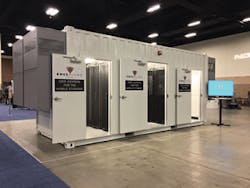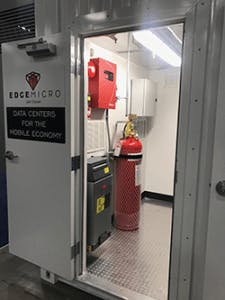The Next Big Wave in the Internet Will Happen at Cell Sites —
It’s a really tough time to be a wireless provider. Mobile Network Operators (MNOs) are getting squeezed by challenges that are steadily eroding the profitability of the wireless services they deliver, and those challenges will only get worse. The demand for bandwidth is rising at a rate that they can barely keep up with, while the backhaul costs associated with delivering that content is mounting with each GB of data those wireless devices utilize. To make things even worse, there is strong downward pressure on what MNOs can charge customers. This situation is the result of major trends in the wireless market that are not going away.
One by one, the major providers have each rolled out unlimited data plans in order to "keep up with the Joneses," and that has put their revenue-per-GB metrics in a death spiral as mobile devices devour more and more content. Twelve months ago, the average revenue per user (ARPU) was $8.80 per GB per month; that revenue has dropped to less than $2.00 per GB. In business school, they would charitably call this "unfavorable market conditions." And the pressures will only intensify given the projections for even higher bandwidth demands and continued price competition among wireless providers.
Two photos of the cell tower micro data center prototype.
The situation is tough and getting tougher for MNOs, but the good news is that those challenges are creating a major opportunity for the wireless tower industry. That is because the solution to what is ailing MNOs — not to mention content providers, consumers, and enterprise end users — will be solved at the base of thousands of cell towers.
The pressures on MNOs are not just a temporary bump in the market. Mobile traffic is projected to increase up to 8 times over the next 2-4 years. If we look at only consumer appetite alone, it is being driven by more and more users who utilize their iPhone or Galaxy not simply as their phone, but as their TV and their primary computing device. That means that LTE networks must deliver:
• The latest binge-worthy show on Netflix or HBO.
• The big game on Sunday night.
• The latest funny cat videos that have gone viral.
• The Facebook Live feed of that distant cousin’s bar mitzvah.
• Access to the biggest shopping sites and online computing services.
• Not to mention all the targeted advertising that gets delivered along with that.
The backhaul costs associated with that consumer demand, combined with data for enterprise wireless devices like Internet of Things (IoT) sensors, is getting higher every month. And those requirements would grow in multiples as MNOs grapple with the data demands of:
• Self-driving cars that will rely on wireless networks.
• Virtual/augmented reality applications that consumers will use on their phones.
• Billions of IoT devices as more companies transition from pilot projects to large-scale deployments.
• And applications that are yet to emerge.
As consumers and enterprise customers want to access more and more of that on LTE mobile devices, it costs more and more for MNOs to deliver that from the centralized data center infrastructure that exists today. This is all contributing to the very uncertain future for MNOs that ISE magazine has been analyzing. (See "Preparing Now for an Uncertain Future" at https://isemag.com/2017/11/preparing-now-for-an-uncertain-future/.) Many of those same pressures exist on content providers as well: Consumers expect to watch Game of Thrones anytime, anywhere, to figure out what those ice dragons are about. And football fans expect to watch the Patriots-Ravens game live without buffering issues.
Then, the enterprise customers expect their IoT sensor network deployments to have LTE access on demand for the real-time connectivity that the networks are designed around. The latency that is inherent to centralized data center infrastructure is a recipe for end-user dissatisfaction. Latency is unavoidable when a data packet needs to travel thousands of miles, over multiple hops, through a long line of switches and gateways — each adding milliseconds of delay that add up to a frustrating experience for consumers and poor performance for enterprise devices that rely on low-latency connectivity. For MNOs like AT&T, Verizon, T-Mobile, and Sprint, and for content providers like Google/YouTube, Facebook, Netflix, Amazon, Akamai, and others, the current network infrastructure doesn’t work.
Let’s Get Closer
As I mentioned above, the solution is at the mobile edge provided by cell towers across the US and around the world. Mobile Edge Computing (MEC) is a term that most readers of ISE magazine have likely heard, but many do not realize that cell towers are the only infrastructure that makes sense as a foundation for deploying edge computing on a large scale. MEC is about moving content closer to end users in ways that reduce backhaul costs, reduce latency, increase end-user satisfaction, and other very good things. There are differing models for how to do it, but the only model that makes sense and that solves the challenges above in a comprehensive way involves cell towers as a centerpiece.
If you want to get as close as possible to end users and their mobile devices, what better place to do that then the exact location where their LTE signal first connects with a tower. If you put what an end user wants at the tower rather than housing it in some big central database thousands of miles away:
Wouldn’t latency be nearly eliminated?
Wouldn’t they have a dramatically better user experience?
Wouldn’t it eliminate backhaul costs?
Wouldn’t it solve many of the problems that MNOs, content companies, and end users, are experiencing?
The answer is yes, yes, yes, and yes. These sites have fiber connectivity, power, end-user proximity, and physical space, to deploy content and computing services as close as possible to end users. When people talk about "the edge," they should think about cell towers because wireless networks can’t get any closer to mobile devices.
So how do you put micro data centers at those sites? Wireless providers and content providers have 2 options:
Option 1. Build out their own capital-intensive, geographically-massive, risk-filled construction initiatives. Understanding they lack the resources and expertise to successfully deploy hundreds of sites.
Option 2. Or have a third party do it in a way that eliminates the capital expense and risk using a shared, colocation-style network-neutral data center environment.
The latter approach is the only one that makes sense financially and technically. It is already happening. EdgeMicro, for example, is in the process of implementing hundreds of these micro data center deployments in markets where the pain points are the most intense for end users, MNOs, and content providers. This represents a major new era for computing that is just as significant as the wireless revolution, and, once again, cell towers are at the center of this tech transformation.
In fact, our belief is that the cell tower industry has THE key ingredients for opening the door to this next big wave of the Internet. It’s a very good time to be in the wireless industry, because we will be making the future a reality with projects that transform cell towers into the central nervous system for Mobile Edge Computing worldwide.


